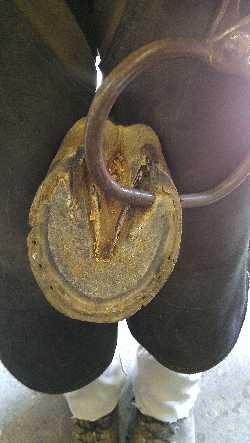Farriers and vets rely heavily on hoof testers to decide if the hoof is sore or not.
Many vets use the hoof tester as a first order of business when diagnosing lameness. All farriers should have a pair of hoof testers in the shoeing box. Since much lameness begins with the front feet, it is imperative to know when problems are beginning there.
Checking suspect feet often with hoof testers is the easiest way to monitor the soundness of horses' hooves. One could argue that any front feet of a racehorse are "suspect" and hind feet are not totally excluded. The question is what to look for, and when is it a problem? Many race horses will show some degree of reaction to pressure in the heel area of the front feet. It is the most common--but not only--area to find a positive reaction.
A positive reaction to hoof testers can be anything from a mild flinch to raring up and snatching the hoof away from the person testing. Many horses that the vet and trainer consider "sound" will still show some degree of reaction when tested. This does not mean it is time to knee-jerk into drastic shoeing changes and pain management. It does mean that you need to carefully scrutinize the heel fit of the shoes and, equally important, the way the hoof is being trimmed. Also, keep checking that horse often. You may very well save yourself some headaches later.
 A hoof tester is a great tool for locating pain and soreness in a horse's foot.
A hoof tester is a great tool for locating pain and soreness in a horse's foot.
To determine when major damage has taken place requires some repetition and experience. Knowing what areas are sore, how sore, and what that means in terms of anatomy and shoeing isn't easy to learn. Knowing that you have a problem, or potential problem, is. As I said, many "sound" horses will show mild reaction to hoof testers. If I wanted to take a pair of 18-inch GE testers and squeeze hard, I could darn near make a dead horse stand up. Some finesse is needed, and is not hard to get a feel for.
I have seen some badly bruised heels that show little reaction to hoof testers. And I have had horses react to my thumb and forefinger without even using tools. For anyone training racehorses, this is a great procedure to learn and a simple tool to monitor the well-being of the horse's hoof soundness and thus, performance.
As with anything, the earlier hoof pain is noticed, the easier it is to remedy and the fewer associated complications will arise. All vets have hoof testers, all farriers should (if they don't, suggest it). If one isn’t comfortable checking the hoof, simply get the farrier to do so at every shoeing interval and watch for yourself to know what that horse’s “normal” is.
Obviously horses, like people, have varying degrees of pain tolerance so knowing what normal is can change among individuals. The key is noticing when any individual changes for the worse and addressing it early. Monitoring this often, making changes when necessary, and keeping those hooves from being constantly sore will greatlyimprove that horse’s productivity over the course of an entire racing season. It might even keep you from turning a positive into a negative.
Veteran Standardbred farrier Steve Stanley of Lexington, Ky., authors a monthly column for Hoof Beats, the official harness racing publication of the U.S. Trotting Association. The American Farriers Journal Editorial Advisory Board member offers plenty of practical advice that will be of special interest regardless of the type of horses that you work with. Click here to read more from Steve Stanley's Hoof Beats series.








Post a comment
Report Abusive Comment